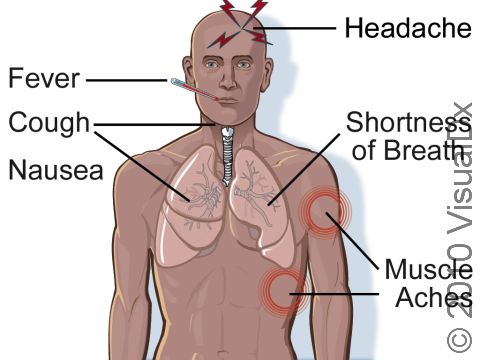Avian Influenza H5N1 (Avian Flu, Bird Flu)
Avian influenza, or bird flu, is the name for a certain strain of the influenza virus that is usually found only in birds but may occasionally be transmitted to humans, sometimes causing a serious illness.
Avian influenza tends to be carried by wild birds, which are not usually symptomatic from the virus, and passed to domestic birds, such as chickens, turkeys, and ducks. Domestic birds tend to get either a very mild illness with few symptoms or a very serious illness causing death within days. The virus is very contagious among birds and is transmitted via their respiratory secretions, saliva, and feces. Humans can acquire the virus through contact with infected birds or contaminated surfaces, such as chicken coops and cages. The virus is not thought to be contagious from person to person. The virus is not passed to humans through undercooked poultry meat or eggs.
In the world today, there are occasional outbreaks of avian flu in birds, mostly in Asia, Africa, Europe, and the Near East. These outbreaks are usually confined to birds, but humans can become sick and have died from avian flu. The US government monitors the progress of avian flu very carefully because of the potential for human infection. If the avian flu were to create an epidemic of human illness, it would be very difficult to contain and treat it, as one of the unusual properties of both the human and avian influenza is the ability to change quickly.
Who's At Risk?
Anyone in close contact with birds has the potential to be infected with avian influenza. In particular:
- Poultry farmers
- Poultry handlers and processors
- Visitors to poultry farms or petting zoos
There are very few cases of avian influenza reported in the US, probably because the very strict monitoring for signs of illness in domestic birds and exterminating birds with signs of illness that is done in the US. Far more cases of avian influenza in humans are reported in developing nations in Asia, Africa, and Southeast Asia, and travelers to these areas should be aware of the hazards of coming into contact with birds or fowl.
Signs & Symptoms
Avian influenza causes a flu-like illness.
Mild symptoms include:
- Fever
- Cough
- Feeling generally weak and achy (malaise)
Sore throat
More severe symptoms include:
- Pneumonia
- Respiratory failure
- Death
Self-Care Guidelines
To prevent avian influenza:
- If you are in an area where avian influenza is a risk, protect yourself by practicing good hand hygiene.
- If you will be handling birds known or thought be infected, protect yourself with gloves, goggles, a medical gown, shoe covers, and a mask designed for very small particles, such as a tuberculosis mask.
- There is little known about transmission of avian influenza between humans, but to be on the safe side, do not allow secretions, sneezing, or coughing to contaminate other humans, particularly children, the elderly, and the immunocompromised.
Treatments
There is no certain treatment for avian influenza. Some drugs (antivirals) that are used to treat human influenza may be helpful for patients with avian influenza, but for both, these drugs are designed to shorten the duration and severity of symptoms; the illness must run its course. The earlier in the course of illness these drugs are started, the better. If one person in a family develops avian influenza, the other family members may receive an antiviral in order to protect against illness (although at this time the disease is not thought to be contagious person to person). There is a specific vaccine for one strain of avian influenza; the vaccine will be made available to the public in the event of an outbreak. The human influenza vaccine that the Centers for Disease Control and Prevention makes public every year does not protect against avian influenza.
Visit Urgency
Contact your doctor for any illness with high fever (ie, temperature greater than 39°C [102°F]), inability to tolerate foods or liquids, or bad abdominal pain.
Last modified on October 5th, 2022 at 7:02 pm

Not sure what to look for?
Try our new Rash and Skin Condition Finder

